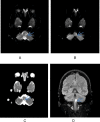Posterior circulation stroke presenting as a new continuous cough: not always COVID-19
- PMID: 33431481
- PMCID: PMC7802704
- DOI: 10.1136/bcr-2020-240270
Posterior circulation stroke presenting as a new continuous cough: not always COVID-19
Abstract
A 19-year-old man was admitted with a 2-week history of continuous cough along with a day history of acute onset unsteadiness and hiccups. Given the current pandemic, he was initially suspected to have COVID-19, however he tested negative on two occasions. Subsequent brain magnetic resonance imaging (MRI)confirmed a small left acute and subacute lateral medullary infarction with chest X-ray suggesting aspiration pneumonia with right lower lobe collapse. This is a distinctive case of posterior circulation stroke presenting with a new continuous cough in this era of COVID-19 pandemic. We anticipate based on MRI findings that his persistent cough was likely due to silent aspiration from dysphagia because of the subacute medullary infarction. It is therefore imperative that healthcare workers evaluate people who present with new continuous cough thoroughly to exclude any other sinister pathology. We should also be familiar with the possible presentations of posterior circulation stroke in this pandemic era.
Keywords: infectious diseases; stroke.
© BMJ Publishing Group Limited 2020. No commercial re-use. See rights and permissions. Published by BMJ.
Conflict of interest statement
Competing interests: None declared.
Figures


References
Publication types
MeSH terms
LinkOut - more resources
Full Text Sources
Other Literature Sources
Medical
